I have been a bit busy on other things recently, but have now completed my 18th Century British Baggage Train. I had made one wagon earlier, for my Prestonpans set-up, but have now made several more vehicles.

The wagons are all scratch built, from component parts as seen below.

The horses and rope traces are from the Hät Napoleonic French Artillery Limber set (there are 18 horses in the set, which is very useful). The white sections are all from a Wills (now Peco) model railway fencing set and the brown wood base is from a Wills (now Peco) model railway plank board. The small front wheels are from an Airfix Napoleonic French Artillery set and the rear wheels from a Strelets Russian Artillery of Peter I set. I had used the guns from that latter set to represent French 16 pounder Siege Artillery, as shown here, but felt that the wheels were too small, so replaced them with larger ones from an Esci (or Italeri re-issue) Napoleonic British Gun. These Strelets wheels were fine for my baggage wagons, which would not necessarily have been completely standard.
Here are the partially assembled components of the wagon itself.

The shafts were pieces of sprue from the Wills (now Peco) model railway fence set and I now shaved them to make them pointed in the front, then added a piece of sprue to join them together. Another piece of sprue will be used to join the small front wheel axle to the underside of the wagon. The fencing pieces used for the sides and front of the cart have been given a diagonal shape on their front sides and a piece of fencing sprue has been used as these diagonal corner posts. Those sides and front were glued to the plank base. The axles are pieces of sprue, welded to the wheels.
Here is an assembled wagon, with all of the component parts welded together. The shafts have been heated slightly to give them an inward curve.
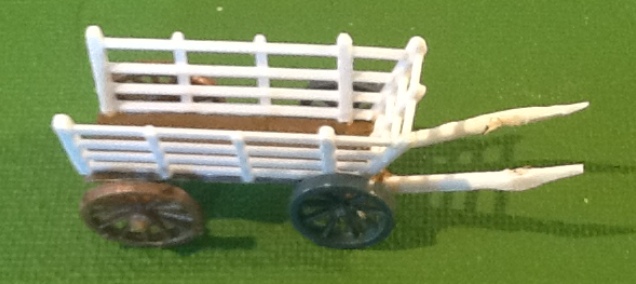
The underside of the wagon looks like this.
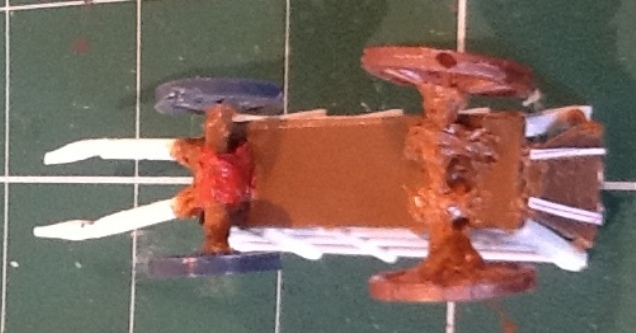
The front wheel axle has a block of sprue between it and the floor of the wagon. This represents the turntable which allows the small front wheels to turn, and the floor of the wagon to be level. I have modelled a tailgate from a piece of planking.
I stuck the horses to a stiff card base, 130mm long and 40mm wide. They are slightly closer together than the Hät design originally was. I drew a 15mm square on the front where the walking driver will be placed.
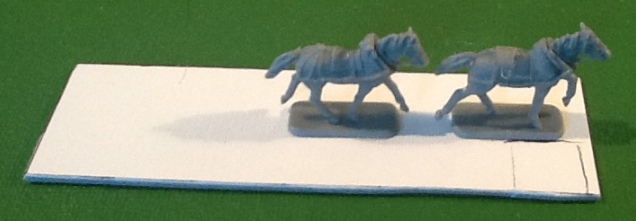
I then welded sprue all over the base. As it cools it does tend to shrink and cause the base to curve upwards.
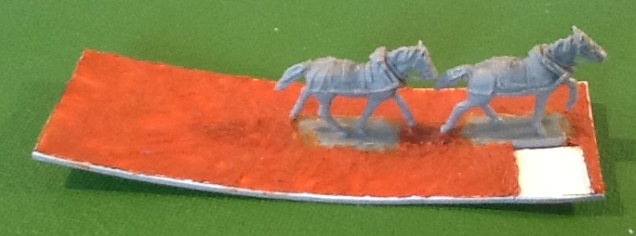
I straightened this out then added the traces for the horses by welding them on. The traces are slightly shorter than originally manufactured as the horses are closer together than Hät designed them to be. I also welded a lip of sprue around the position for the walking driver, so that he can slide into it, but be held firm when he is in position. I actually put the driver in position, then welded each of the three sides in turn, sliding the driver out between each side welding session as the sprue cools.

For my 18th Century British walking drivers, I have previously used old Airfix AWI figures, but I have run out of them. Some of the walking drivers for the baggage train have therefore been converted from Airfix Napoleonic French Infantry. The original figure is on the left, the second figure has had his pack and musket removed, left arm repositioned, coat lengthened, shako welded into a tricorn and his ramrod welded into a whip. The third figure is the same, but mounted on a piece of magnetic tape (to give him weight) which is then stuck to a thin 15mm square card. The right hand figure is the same with plastic sprue (from the cut off pack) welded at a slope to the base to complete the model.

I used a bed from the Atlantic Ancient Life set as the top of the baggage itself, with a mixture of figures from that same set and the Airfix Wagon Train set as camp followers.
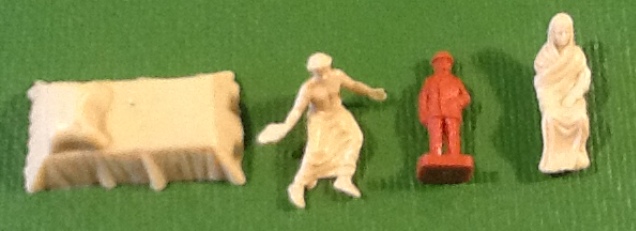
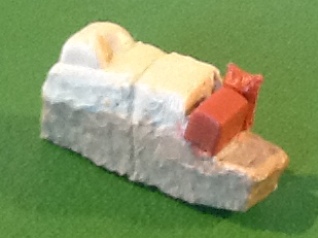
Here is the baggage welded into a suitable shape to fit into the wagon, by welding pieces of sprue below the bed. I have also added a chest and sack from the Airfix Wagon Train set. I have scored to sides of the baggage to represent different bundles.
Here are some of the converted camp followers. The first figure is Atlantic Ancient life, now carrying a baby, and the other two are Airfix Wagon Train.

I painted the horses, wagon, baggage and figures separately. I then joined the wagon to the horses by welding the shafts to the horses and welding the wagon wheels to the base. I fixed to figures to the baggage with a mixture of pinning, glueing and welding as necessary. I then glued the baggage into the wagon, pressing it down hard for a good fit. Here is the first of the new baggage wagons.

Here is the second new baggage wagon. The seated figure in the front, wrapped up in a tartan plaid, is from the Atlantic Ancient Life set. The figure sprawled on top is converted from the Airfix Wagon Train set.

I also made one forage wagon. I actually already had the wagon, spare from a previous Napoleonic set up, but without front wheels or horses. As I assembled it I realised that the wagon was slightly longer than the baggage ones. I solved this by putting the horses even closer together.
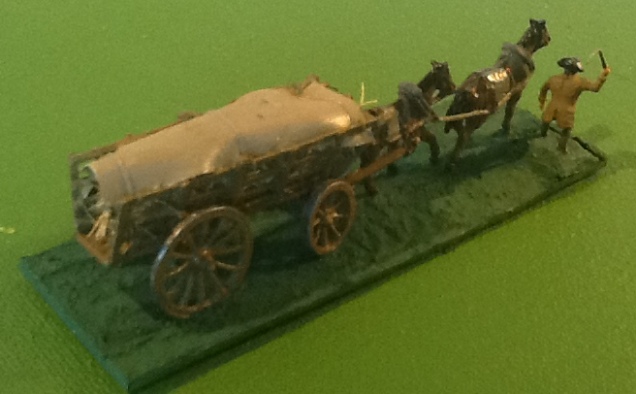
The forage is cut off pieces of thin rope, or cord, glued together and painted in a brown/yellow colour. The tarpaulin is a piece of plastic bag, held down with thin wires to represent ropes.
Here is the cord or rope being cut into sections for the forage.

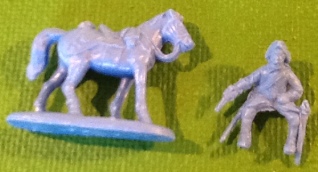
For most of the Jacobite Rebellion, War of Austrian Succession and Seven Years War, the British Commissary General was Laurence Dundas. I wanted a suitable figure for him, so I used this Strelets one, from their Trabants of Charles XII set.

Here is the completed figure of Laurence Dundas. His tricorne was originally on the back of his head so I have repositioned it. I have also removed his carbine from his right side and the pistol in his right hand. I then repositioned his right arm as though he was pointing at something. I reshaped the horse shabraque into a simple square and docked the horse tail, as I have for all of my British horses. I painted him in a simple dark blue coat with cream breeches.
It may be of interest that he was created as a Baronet in 1762.
Finally, here is the complete baggage train on the march. The photo is a bit dark, so I will take a better one later. This baggage train could be used by any 18th Century or Napoleonic Army. It would just need the walking drivers changed for some armies, but this is easy as they just slide out of the wagon base.

Really nice…love the conversions
LikeLike
Hi Paul, I always enjoy conversions. When I started, over 50 years ago, that what we all had to do.
Rod
LikeLike
Do you play any computer war games? Do you play with any simulataneous (complex and realistic) execution rules for your tabletop games? I really like your historical strategy and logistics posts.
LikeLike
Hi Geoff, I have occasionally played computer wargames, but never got into them. I have used a number of different rules for my wargame figures over the last 60 years, as mentioned in my “About” page, but am always looking for the “perfect” rules.
Rod
LikeLike
Realistic Napoleonic warfare is still untapped by big software. I’ve only studied the battles for about 5 years and find it difficult to conceive tactically. People like you are one in a million who compile different sources and produce essays on the subject. I check back here regularly and hope for some new historical resources.
LikeLike
Hi Geoff,
I plan to publish a couple of posts later this year on evolution of tactics in the 18th century and tactics at the end of that century.
Rod
LikeLike
I have really enjoyed reading through your blog. I really like some of the lesser covered items regarding the Jacobite rebellion (such as Baggage Train and the various forts), it really gives me inspiration to create these auxiliary items.
LikeLike
Hi Chris,
Glad you liked it.
Rod
LikeLike